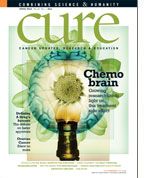Publication
Article
CURE
The Machine and Me
Author(s):
A power outage gives a patient new perspective on radiation and life.
I have never felt as alone as that first day. What was I doing here, lying exposed and vulnerable under a machine poised to shoot radiation into my body? I knew the drill, but when the technicians left and closed the door, the reality hit. I had cancer. Surgery had removed the tumor, and now radiation from this machine was supposed to seek out and destroy any stray cancer cells it could find.
As a cancer patient, you feel you have lost control over your life. You suddenly belong to the “health care system.” You are all too willing to go along with the directions. After all, cancer is a life-threatening illness. You report at the same time, five days a week for 35 days. After a while, you learn to wear clothes that are quick and easy to remove as you go in, lie down, contemplate the leaves someone has thoughtfully placed on the ceiling, listen to the music or your own thoughts, get up, make small talk with the technicians and leave. But the questions remain.
You suddenly belong to the “health care system.” You are all too willing to go along with the directions. After all, cancer is a life-threatening illness.
One special day the electricity failed just before my appointment. “Why don’t you go over to the cafeteria and have lunch,” the technician said. “It is Polynesian day, plus with no electricity, the computers don’t work. Lunch is free.” I walked between the buildings and into a cafeteria decorated with palm trees and streamers. How can a hospital be both cheerful and frightening at the same time? The pork sandwiches looked so good. One never knows what a day can bring, and this one brought a gift. Standing near me, piling his tray with food, was an old friend and the perfect person to answer my nagging questions. He was an expert in cancer radiation, and he knew what had been happening to me.
“Let’s take our trays out in the sunshine and have lunch,” he suggested. The day was relatively cool for summer, and we chose a table away from others. We caught up on our lives and families.
“Did I cause my cancer?” I asked. The preceding months had been very stressful at work. If I had been trying my best to cope with life and then got cancer, what hope was there for a cancer-free future? I didn’t know how to live differently.
He leaned back in his chair. “Science is concerned with cause and effect. In only a few cases can we make a direct link—smoking is one. We know that smoking irritates cells, and sometimes this irritation results in cell damage leading to cancer. But in other cases, it is not as clear. Stress may play a part, but there is no definite link between stress in life and cancer. Sometimes, we just don’t know.”
“What is happening to me during radiation?” I asked. “Sometimes the technicians seem to be using more energy, or it lasts longer. Sometimes it almost hurts.”
“We are encouraging cells to commit suicide,” he said. “Normal cells have the ability to repair themselves. Cancer cells divide much more rapidly than normal ones, so they are more susceptible to DNA damage. By giving radiation every day in specific amounts, we allow normal cells the time to repair but drive the cancer cells to the point where they recognize they are damaged. If a cell discovers it is damaged beyond repair, it will destroy itself—commit suicide.”
“Commit suicide.” What a delightful thought. We discussed much more that day—that scientists aren’t sure whether they actually destroy the cancer cells through radiation or cause them to go dormant for decades, how the radiation machine works and the types of radiation used, but these two thoughts are what stuck in my mind. I, through the way I coped with stress, did not cause my cancer; and every day I was driving the cancer cells to despair and suicide. As I walked back to the radiation oncology unit, I realized I had been given new courage—en-couraged. Go for it, machine!






